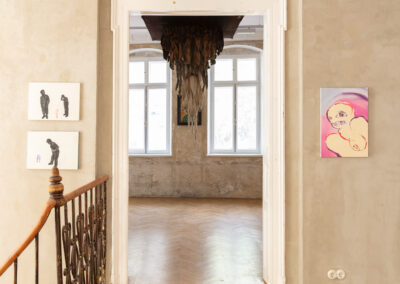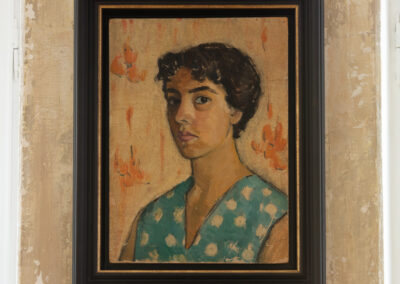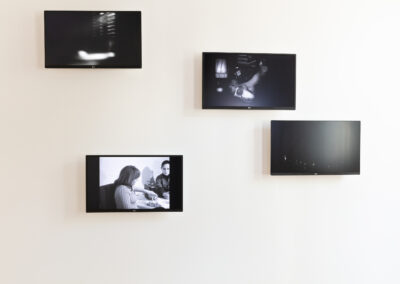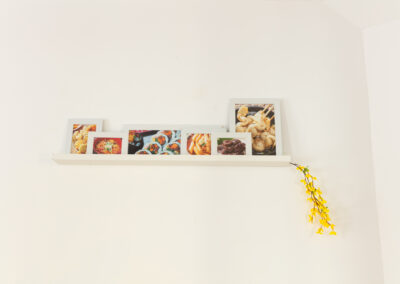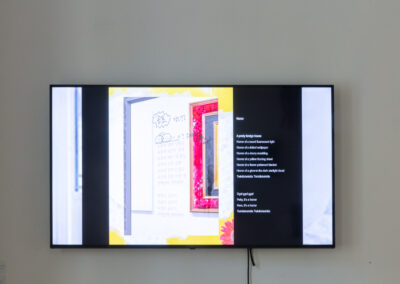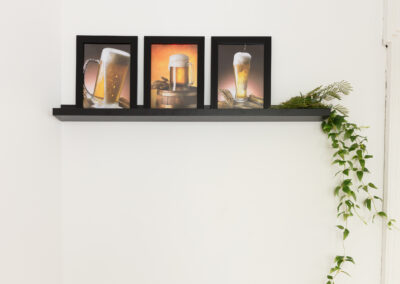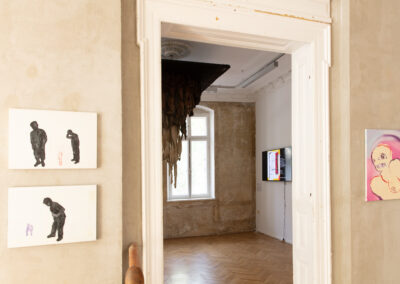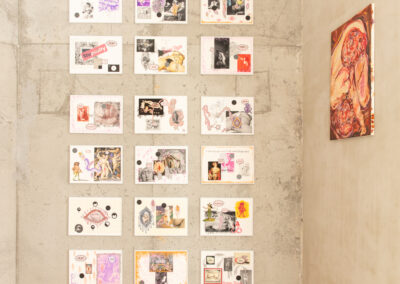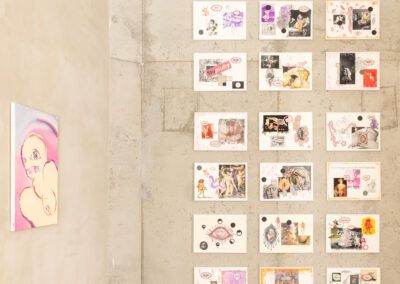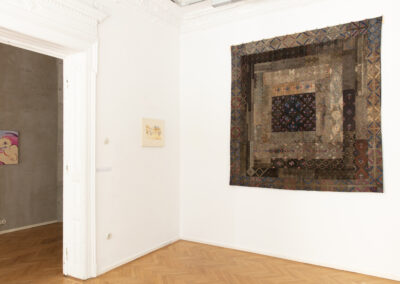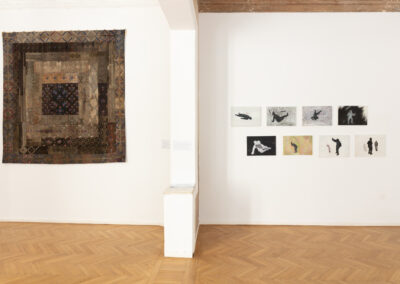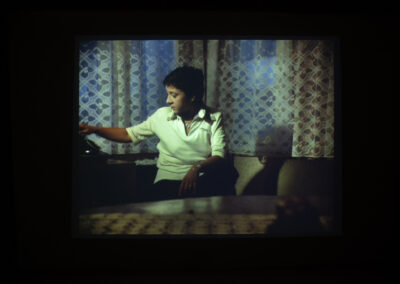Seolhui Lee (b. 1987, lives and works in South Korea and Denmark) is the artistic director for the Korean Pavilion at the 2024 edition of the Venice Biennale together with Jacob Fabricius and a curator at Kunsthal Aarhus in Denmark (2023–present). She previously served as the head of the exhibition team for the Busan Biennale 2020, was a curator at the Seoul Museum of Art (2018–2019) and worked for the National Museum of Modern and Contemporary Art, South Korea (2012–2013). Lee has also served as an adjunct professor at the Korea National University of Arts (2019–2022).
Anca Mihuleț worked in the curatorial team of Singapore Biennale 2019. In 2021, she curated the exhibition Chronicles of the Future Superheroes at Kunsthalle Bega in Timișoara, Romania; the second edition of the exhibition was presented in 2023 at the National Museum of Contemporary Art in Bucharest. Recently, Anca Mihuleț and Irena Bekić co-curated Andreja Kulunčić’s research project You Betrayed the Party Just When You Should Have Helped It at the Museum of Modern and Contemporary Art in Rijeka (2022) and the Vargas Museum in Manila (2023). This year, she will curate the exhibition Ghost Dancer at the Art Pavilion in Zagreb.
Irina Botea Bucan has developed a symbiotic artist-educator-researcher framework that challenges dominant socio-political ideas and emphasizes human and non-human agency. She has participated in the Venice, Prague, and Gwangju Biennials and exhibited at the Pompidou Centre, Jeu de Paume, Kunsthalle Winterthur, and Reina Sofia. She has received awards including the Impakt Film Festival Silver Award and the International Residence at Recollets, Paris. Collaborating with Jon Dean since 2013, she also teaches at the School of the Art Institute of Chicago and is pursuing a PhD at Goldsmiths University titled “Unfinishing the Cultural Houses.”
Jon Dean has been active in the overlapping fields of community-based participatory arts and adult education for over thirty years. A diverse and extensive professional career has witnessed Jon developing and delivering community arts, experiential learning, and cultural programmes across the UK, Romania, and beyond… at the core of these various activities, Jon has consistently embedded the idea that community arts is an aesthetic methodology rooted in differentiated and negotiated strategies designed to place participants at the very core of creative expression and artistic production. Ultimately, a process of personal, social, and critical engagement structured to create a living cultural democracy. Working in collaboration with Irina Bucan, Jon’s projects have been featured in Fundata (Remarkable Romania Project), Timișoara, Bucharest (Rezidența 9, Arthub, Salonul de Proiecte), NTU, CCA Singapore, La Kunsthalle Mulhouse Le Monument. Together with Irina, they have created Casa Rădești residency in Romania.
Choi Yun (b. 1989, lives and works in South Korea) graduated from the Korea National University of Art with a BFA and MFA. Her works have been shown internationally through solo shows at CALM – Centre d’Art La Meute (2023, Lausanne), LUX (2022, London), Doosan Gallery (2020, New York), etc., as well as through group exhibitions such as the Busan Biennale (2024, 2018) and the projects of the National Museum of Modern and Contemporary Art (2021, Seoul). Choi’s works have been acquired by the Seoul Museum of Art, Seo-Seoul Museum of Art, and the Busan Museum of Contemporary Art.
Lena Constante (June 18, 1909, Bucharest – November 2, 2005, Bucharest) was an artist, publicist, memoirist, and political prisoner. The daughter of Aromanian writer and journalist Constantin Constante and Julieta, she attended elementary school at Pitar Moș, high school at the “Regina Maria” institution in Bucharest, and university studies at the School of Fine Arts in the capital (painting section), where she was taught by Dimitrie Gusti. Her exceptional abilities propelled her into research work. Interested in aspects of folk art (especially iconography), she joined a team formed by disciples of the sociological school led by Dimitrie Gusti, including Henri Stahl, Mircea Vulcănescu, Harry Brauner, and Xenia Costaforu. The rich repertoire of folk motifs was utilized by the artist in her own sketches, watercolors, and tapestries. Additionally, in the 1930s, she worked on book illustrations and posters.
Jang Pa (b. 1981, lives and works in South Korea) majored in painting and aesthetics as an undergrad and earned an MFA in painting from Seoul National University. She has held solo exhibitions at Humor Garmgot (2023, Seoul), KICHE (2022, Seoul), Doosan Gallery (2017, New York), etc., and also presented group shows at the Art Space Pool (2019, Seoul), Culture Station Seoul 284 (2018), Seoul Museum of Art (2015), among others. Jang’s works are collected at the Seoul Museum of Art, Seoul National University Museum of Art, and the Government Art Bank operated by the South Korean National Museum of Modern and Contemporary Art.
Elena Haschke-Marinescu (October 26, 1936 – October 10, 2000) was born in Galați, Romania, in the family of the German textile engineer Josef Anton Haschke and Maria Haschke; her father’s work and his innovative spirit influenced her future practice. Between 1955 and 1961, she studied at the “Nicolae Grigorescu” National Institute of Fine Arts in Bucharest, and in 1974 she continued her studies at the University of Applied Arts in Vienna. In the first period of creation, Elena Marinescu was interested in textile prints and clothing design, the main source of inspiration being nature, which is why the design elements developed by the artist contained organic shapes, alongside floral and animal motifs. Documentary trips to Bulgaria, Czechoslovakia, Poland, the Federal Republic of Germany and the USSR, the interest in medieval French tapestry, to which was added the affinity for Romanian folk customs contributed to the non-hierarchical and experimental perception of her artistic production, as noted by the critics of the time. She exhibited at the most important exhibitions and salons of decorative arts in Europe, receiving awards at the second edition of the International Quadrennial of Decorative Art in Erfurt, Germany (1978) and at the Triennial of Tapestry in Tournai, Belgium (1993). Elena Marinescu used the haute-lisse technique and traditional weaving methods (loom or warp) preferring common materials to vernacular textiles. In 1984, the artist made the sculptural tapestry that would elevate her practice, Metamorphosis, which is currently in the collection of the Museum of Art in Bacău, Romania. Throughout her career, Elena Marinescu held several personal exhibitions, among which we remember the ones in 1974 at the Simeza Gallery in Bucharest; in 1975 at the Palais Pálffy in Vienna and at the Galerie Stadthaus in Klagenfurt; in 1976 at the Museum of Visual Art in Galați (together with the sculptor George Apostu); in 1977 at the Dansk-Design Gallery in Cologne or in 1995 at the Museum of Art and Ethnography in Bacău. Her last personal exhibition took place in 1996 at the Romanian Cultural Institute in New York. Her tapestries were included in numerous group exhibitions, among which we mention: Triennale of Decorative Arts, Dalles Hall, Bucharest (1973, 1976); Decorative Arts Salon, Museum of Art Collections, Bucharest (1979); Decorative Arts Quadrennial, Dalles Hall, Bucharest (1980, 1984, 1988) or the First Edition of the Romanian Tapestry Triennial, Palace of the Parliament, Bucharest (1994). Elena Marinescu’s works can be seen at the Museum of Art Collections in Bucharest; the Museum of Visual Arts in Galați; the Museum of Art in Bacău or the National Museum of Bucovina in Suceava.
Nho Wonhee (b. 1948, lives and works in South Korea) earned her BFA and MFA in painting from Seoul National University and worked as a professor from 1982 to 2013 at Dong-Eui University in Busan. Nho recently opened a solo exhibition at Park Soo Keun Museum in Yanggu in conjunction with receiving its art award. Her works have been shown in numerous museums and biennales, and also collected in the South Korean National Museum of Modern and Contemporary Art, Seoul Museum of Art, Busan Museum of Art, and Gyeonggi Museum of Modern Art, etc.
kinema ikon – multimedia workshop – was founded in 1970 by George Săbău. in over 50 years, kinema ikon has made experimental films on 16 mm, films in digital format, video and hybrid installations, interactive cd-roms and net.art, hypermedia installations, experiments that include emerging technologies (NFT, IoT, 3D print, apps). all the supports used by kinema ikon have become outdated over time and the constant concern of the group is to maintain the works in a format accessible to the present moment.
Nho Wonhee (b. 1948, lives and works in South Korea) earned her BFA and MFA in painting from Seoul National University and worked as a professor from 1982 to 2013 at Dong-Eui University in Busan. Nho recently opened a solo exhibition at Park Soo Keun Museum in Yanggu in conjunction with receiving its art award. Her works have been shown in numerous museums and biennales, and also collected in the South Korean National Museum of Modern and Contemporary Art, Seoul Museum of Art, Busan Museum of Art, and Gyeonggi Museum of Modern Art, etc.
Ada Pistiner was born in Iași in 1938. In 1960, upon graduating from the Faculty of Philology at the University of Bucharest, she was employed as a documentarian at the National Film Archive, and from 1963, she worked as an editor at the “Alexandru Sahia” Studio. A peer of filmmakers like Radu Gabrea, Iosif Demian, and Mircea Moldovan, in 1968, Ada Pistiner graduated from the film directing courses at the Institute of Theatre and Cinematographic Arts, having studied under Mircea Drăgan and Iulian Mihu, in the first class after a ten-year suspension of the Film Faculty courses. After completing her studies, she continued her work at the “Alexandru Sahia” Studio as a documentary film director. In addition to numerous utilitarian films she produced (primarily occupational safety films, but also advertisements and technical films), Ada Pistiner stood out with a series of democratic-spirited reports that consecutively won the ACIN award between 1977 and 1981 (“A Team of Young People… and the Others,” “A Cultural Center,” “And…,” “Realistic Arithmetic in Seini”). In 1979, she directed her only fiction film, Stop-cadru la masă (“Freeze-Frame at the Table”), a feature film that was unique for its time, earning the ACIN Opera Prima award. She continued making documentary films until 1986, when she emigrated to Israel. After the Romanian Revolution, Ada Pistiner returned to the country and produced several more documentaries for the Sahia Studio and filmed the video works Performance and Contemporaries in Bucharest.
Prietena mea genială 나의 눈부신 My Brilliant
Artists: Irina Botea-Bucan & Jon Dean, Choi Yun, Lena Constante, Jang Pa, kinema ikon, Elena Haschke Marinescu, Nho Wonhee, Ada Pistiner
Curators: Seolhui Lee & Anca Mihuleț
20.09.-19.10.2024
ARAC, 26 Popa Soare Street, Bucharest
My Brilliant Friend is a project born out of the curatorial friendship between Seolhui Lee and Anca Mihuleț. The two curators met in 2019 while working for the Busan Biennale and Singapore Biennale, respectively, trying to solve the mystery around a video work by the Romanian-Cuban artist Sandu Darie. Their conversations and curatorial exchanges expanded over the past years, with comparisons between Romania and South Korea taking precedence. In the meantime, Seolhui visited Romania twice, developing a strong interest in post-conceptualism and local architecture.
Uniting more than ten artists from Romania and South Korea, the exhibition revolves around the similar history of domestic and community life in the two countries; influenced by the current processes of social and political restoration, the discussion and research also reflect how the perception of women has been shaped in cross-cultural contexts. The project brings into question narratives and personal histories relevant to understanding the concept of family and community in South-Eastern Europe and Eastern Asia. Central to this project is the idea of home: people, objects and situations that enter, exit or populate intimate family spaces. The selected artists depict fragile yet complexly articulated spaces that are shaped by close relationships between family members or tight communities.
The title of the exhibition, which is identical to the acclaimed novel by Elena Ferrante published in 2011, serves as a code to navigate the process of building the project, although the exhibition doesn’t contain any references to the book itself. We selected three Korean and five Romanian artistic positions in an attempt to delineate a milieu of stances that render both familiarity and a sense of belonging, together with moments of care and tension. The displayed projects talk about the everyday life of the artists and the people around them, as much as they talk about the dreams, memories and possibilities of a generation.
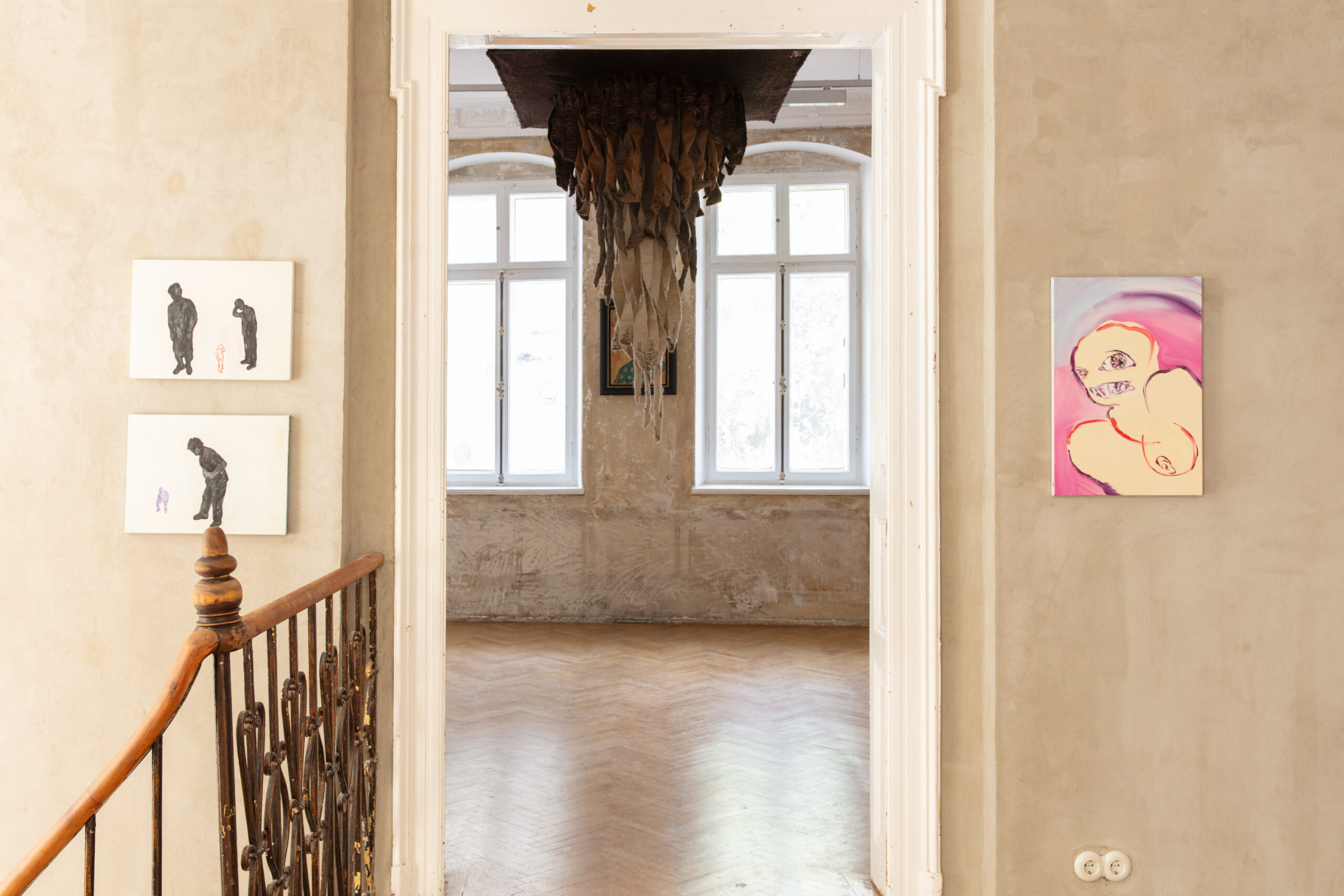
In an interview, Lena Constante talked about how her mother used to tell her “All bad for good.” (also having the meaning “It was for the best.” or “It was a blessing in disguise.”). After serving the twelve years in prison, she was wondering how that dark period could ever transform into something good. And then she started to work on her monumental tapestries and came to realise how all negative energies can be channeled into something beautiful; sitting on her knees for long hours, Lena Constante would compose the puzzle-like tapestries, leaving the legacy of resilience and the power of imagination for the generations to come. In 1976, the city museum from Oradea, a city in Western Romania, organized an exhibition of her tapestries, following the one in 1974 where her works were shown in Orizont Gallery in Bucharest. The tapestries were received with mixed feeling as many conservative critics considered that she destroyed the national heritage by cutting old traditional blouses. In an article from July 1976, Familia [Family] magazine included the interesting testimony of Cosana Vinca, a peasant from Pădureni village in Hunedoara county; she mentioned that the entire village knew, even the eldest, that they gave her what was broken and would have been thrown away. The clearly specified identity of the peasant and the (unwritten) agreement that existed between Lena Constante and the community in Pădureni is a characteristic of the entire activity of the creator, who combined ethical anthropological research with an imaginative discourse. In the exhibition, we will present a tapestry from the collection of the National Museum of the Romanian Peasant in Bucharest which has previously never been displayed.
Nho Wonhee’s work is recognized as a visual documentation and remark on society, which visualizes her critical view on the state of affairs and role of art. As a founding member of “Reality and Utterance,” an artist collective of Minjung Art, which emerged in the 1980s in South Korea, she aimed to continue her practice in a close knot with the social context to discover and define art’s position in society. For Nho, paintings are a window to everyday life, a platform where concealed and suppressed events emerge. She presents the images of city and daily life on canvas while constructing her unique language of Realism.
A group of young people sitting around a small coffee table drinking beer and listening to a Sanyo radio, laundry hanging in the middle of a room, mirrors and film cameras left unattended in the corners of mysterious spaces, children playing while adults handle serious business – these are just some of the intricate pieces of imagery composed with awareness for a suite of videos produced or centred on the female artists and thinkers part of the collective kinema ikon – Monica Trifu, Marcela Munteanu, Roxana Cherecheș and Liliana Trandabur. On another side, in Valentin Constantin’s film, Gros plan de zi, the central character is the poet Ligia Holuță, who between 1991 and 1992 coordinated Conversația [Conversation], a magazine edited by kinema ikon. Apart from the experimental manner in which the setting and consequently the shooting was done, the final editing of the films contributes to a different view point of life in a creative community in the Romania of the 1980s.
Irina Botea-Bucan and Jon Dean have been collaborating as an artist-duo for over eleven years; each of them has spent more than thirty years working with diverse communities, questioning the dominant hegemonic production of knowledge. Over the past few years, they have prepared and developed many of the projects at their house in Rădești, a village in the Argeș county, Romania; which functions somewhat like a residency for cultural workers and a laboratory of ideas in dialogue with the garden. In 2019, Irina and Jon were selected for an artist residency at the NTU Centre for Contemporary Art Singapore; their research looked into the complex and ubiquitous infrastructure of community centres in Singapore. Befriending the Singaporean film director Yeo Siew Hua and his father, the artists documented the process of designing CCs and responding to the changing roles of such community centres in the city-state. The film produced during that period – CCs – will be shown for the first time in Romania; creating a comparative point of reference between similar institutions within different political landscapes.
The attention given to minor gestures or actions, to food and eating, to decorative fabrics or the interior of restaurants and shops are just some characteristics that make Ada Pistiner’s only feature film, Snapshot Around the Family Table, a relevant and unique production of the Romanian film avangarde. Released in 1980, it follows the story of the architect Filip Halunga, portrayed by the Russian actor Aleksandr Kalyagin, who leaves his family for a short-lived love story with a nonconformist designer. Parallel to the narrative, the director follows the physical and mental transformation of the wife, Clara, played by Dorina Lazăr, and the lover, Nușa Predescu, interpreted by Anda Călugăreanu. The fluctuations of their states of being imbued the story with consistency and drama, while the male character, Filip, is caught in a suspended and contradictory condition, between a feeling of constant doubt and and a sometimes unexplainable easygoingness.
In the territory of contemporary folk culture explored by Choi Yun, ordinary reality seems to be directly connected to a dream world, seeming familiar while simultaneously uneasy to explain in words. Most of the elements making up her works can be described as popular, without meaning they are widely appreciated by the public. They provide neither vivid traces of life nor mementos of a past that has been redeveloped as a tourist destination. The works hold a certain vulgarity in the sense that they belong to the insignificant masses, with elements so much like a cliché that none wish to hold their gaze for long.
Jang Pa explores beyond her own individual identity as a female and observer of her surroundings to experiment with inquiries and perspectives on the boundary between male, female, self and others. Beginning with questions on the possibility of genuine understanding and love for another in the Lady-X series (2015), her works endeavor to break away from the existing perspective on femininity and inspire diverse approaches and attitudes. Jang has recently focused on referencing images in art history to further materialize works, such as in her Flat Hole series (2022).
The interviews and testimonies of Elena Marinescu inform a practice devoted to creating a balance between concept and matter, between folk and cult art, often questioning the role of the artist and of the artistic production. Ever since the 1970s, she had been preoccupied with incorporating new materials in her works, trying to set apart from the traditional means of expression; for the artist, working with textiles was a way to mend domestic life and tradition with a form of sculptural work as she was constantly looking for ways to reconvert space. Even from a chromatic point of view, she was trying to intervene as little as possible on the texture of the thread, choosing a reduced range of natural colors. In the frames of the exhibition, we are presenting the work Sky’s Stripes, which alongside Thought’s Stripes and Earth’s Stripes belong to the trilogy dedicated to the traditional Romanian belt, worn by peasants on work days and also during holidays; when talking about Sky’s Stripes, Elena Marinescu described it as “a tridimensional spatial work” and not a tapistry, dedicating it to the peasants who need the boon from heaven in their activities.
The exhibition is built on causality and confrontation, although it aims to be comfortable and befriend the viewer. There is a balance between the historical times and the locations where each work is set, while an invisible thread creates liaisons between the period of the Korean War and Communism and the colonization and liberation of the body.
Special thank yous go to Horia and Tudor Marinescu for mediating the understanding of Elena Marinescu’s oeuvre.
[English editor: Chance Dorland]
The project Prietena mea genială is co-funded by the National Cultural Fund Administration. The content and outcome of the project are the sole responsibility of the grantee and do not necessarily reflect the views of AFCN.
Credit graphic design: Andrei Reg
Event organized with the support of DACIN SARA.
Partners: Muzeul Taranului Roman, Revista Arta, LG Romania
ARAC is a non-profit organization founded in June 2012, in order to produce and promote contemporary art in Romania and abroad. The initiative of the 58 Plantelor Residency belongs to Anca Poterasu, gallerist and ARAC President. The first edition of the Residency took place in 2015 and it was financed through a grant offered by Norway, Iceland, Liechtenstein and the Romanian Government.

